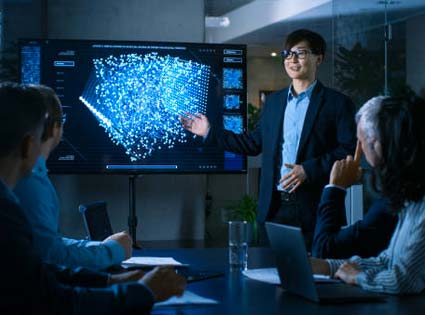by Tamara Halbritter in Oakland Business Review
Software and hardware developers in the Acumen Building Enterprise, Inc. R&D department spend their days sequestered in the “cave,” dedicated to advancing technology to improve transit systems, from revenue collection to train movements. In 2001, R&D staff worked with the San Francisco Bay Area Transportation District (BART) to develop a fare collection product, the Bill-to-Bill Changer (BBC) allowing riders to exchange $10 and $20 bills for $5 bills for ticket purchase; unique and innovative, nearly 20 years ago. Since that time, Acumen has built a solid working relationship with BART and consulting services on numerous project controls, engineering and construction management projects. Acumen’s innovation was exhibited again with the design of products such as the AcuFare 135 Smart Card Reader, which BART recently purchased for use as fare verification devices in 49 stations.
Acumen has also been very involved in BART’s Train Control Modernization Program (TCMP) Communication Based Train Control (CBTC) project. The goal of the TCMP is to improve the aging automatic train control system to allow BART to safely operate more frequent service. The CBTC will replace the existing fixed-block train control system with a service-proven technology to increase capacity, improve safety and reliability, decrease runtime of trains between stations and allow trains to run closer together.
Acumen works on projects that protect the environment
Acumen’s CEO Walter Allen is proud of the work Acumen has done with BART, which has an added bonus, beyond the excellent rapport between client and consultant. “Acumen wants to save the earth by reducing CO2 emissions, and BART rail infrastructure projects facilitate this end goal. We work on projects that improve transit, and we encourage people to use public transit, reduce their use of gasoline-fueled vehicles and increase their use of electric and in the future autonomous vehicles.”
Allen stays informed about transit trends around the world. It is well known in the global transit industry that Europe is leading the world in rail infrastructure integration; Europe is also moving forward with the Paris Climate Accord and is one of the leaders in the fight against climate change. Allen attended an ITS conference and a rail conference in Amsterdam last year and is scheduled to attend the European ITS conference in Lisbon, Portugal in 2020.
California’s High-Speed Rail project is another rail project Acumen is working on that will reduce emissions. Allen is a true believer in this project, which will run from San Francisco to the Los Angeles basin and change the Central Valley. He serves on the Authority’s Business Advisory Council as The Conference of Minority Transportation Officials’ Northern California representative. He gets the word out and connects local small businesses to opportunities resulting from the high-speed rail project. Acumen works with the California High-Speed Rail Authority as part of the Early Train Operator consultant team.
Allen is closely watching high-speed rail progress across the U.S. in Nevada connecting to California, Texas, Washington state and the Northeast corridor. These projects represent huge opportunities to build wealth, connect major urban cities, increase productivity and protect the environment. “We really have no other option, given the demand for transportation and threat of climate change. These projects could be the foundation for a national rail renaissance supported by the Green New Deal,” noted Allen.
Acumen also strives to make transportation equitable. A large number of people are transit dependent or have no transit in their neighborhood to get them to jobs or medical appointments. Said Allen, “Acumen is very interested in assisting transit agencies in implementing and expanding Mobility as a Service (MaaS) — integrating modes of transportation – a way to improve mobility equity.”
The future of transportation with MaaS – a truly integrated system – will result in greater investments in public transit infra-structure, free public transit for all, more electric vehicles on roadways reducing the cost of them, automated vehicles and shuttles carrying more than one person at a time and reducing pollution, car sharing and alternatives to driving including rides from transportation networking companies, shared scooters, bikes and better walking paths.
Allen adds, “This kind of mobility equity future is possible if communities, government and private companies all work together.”
